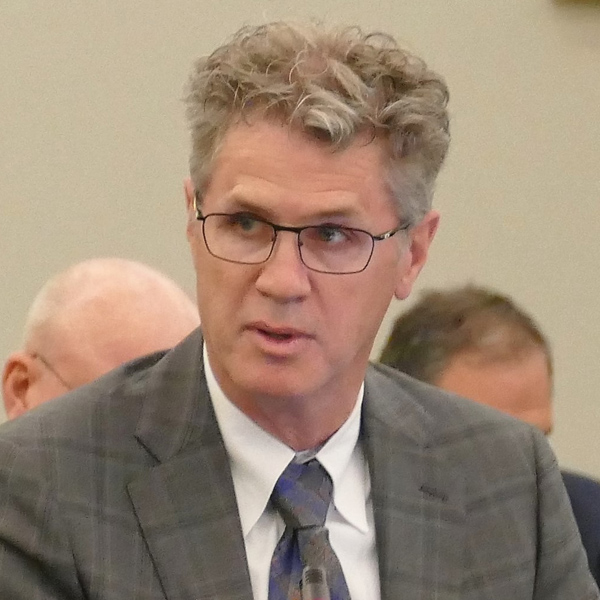COLONIE, N.Y. — Boosted by new tax credits and growing momentum toward decarbonizing buildings, the 2023 NY-GEO Conference last week was nearly standing-room only, with a record number of attendees.
And the room to stand was limited by all the exhibitors on hand at the geothermal heat pump expo last week, some of them wedged into any available space in the corridors.
Geothermal systems have among the lowest operating costs of any heating/cooling system, but for decades, many potential buyers have been turned away by their high upfront costs.
With local, state and federal policy promotion of the technology, and with IRA tax credits to sharply reduce the installation costs, the industry has turned a corner, one speaker after another declared.
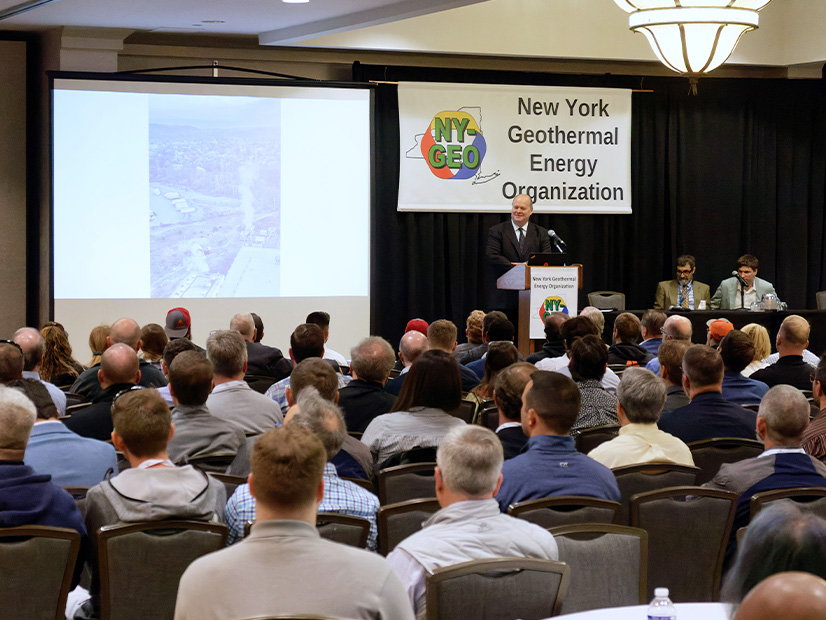 NY-GEO President Jens Ponikau speaks at the 2023 NY-GEO conference. | © RTO Insider LLC
NY-GEO President Jens Ponikau speaks at the 2023 NY-GEO conference. | © RTO Insider LLC
Jens Ponikau, president of the NY-GEO board of directors, recalled being excited to have 62 attendees at the first conference eight years ago and see it grow steadily to 400 last year. More than 700 people registered to attend the 2023 edition.
“Never in my wildest dreams would I have imagined where this technology has gone,” he said.
The industry does still face headwinds, notably a shortage of contractors to drill the bores that act as a source of heat in the winter and repository of heat in the summer. But with structures being one of the largest sources of greenhouse gas emissions, building decarbonization is central to the climate mitigation programs being planned and implemented in New York and elsewhere.
Scott Walsh, director of development for Lendlease, spoke about 1 Java Street, the 790,000-square-foot mixed-use complex it is building on the Brooklyn waterfront. The all-electric building is a significant undertaking, not least because of its geothermal system. Construction crews had to choreograph foundation pile-driving with drilling of 320 vertical bores for the system. (A one-family house typically needs only a single vertical underground loop.)
“It was Santa’s Workshop on our site, to say the least,” Walsh said.
The geothermal climate control system at 1 Java will be larger than any other residential installation in the state, and by serving multiple structures, it is akin to the district community systems that the New York State Energy Research and Development Authority is guiding through a pilot process.
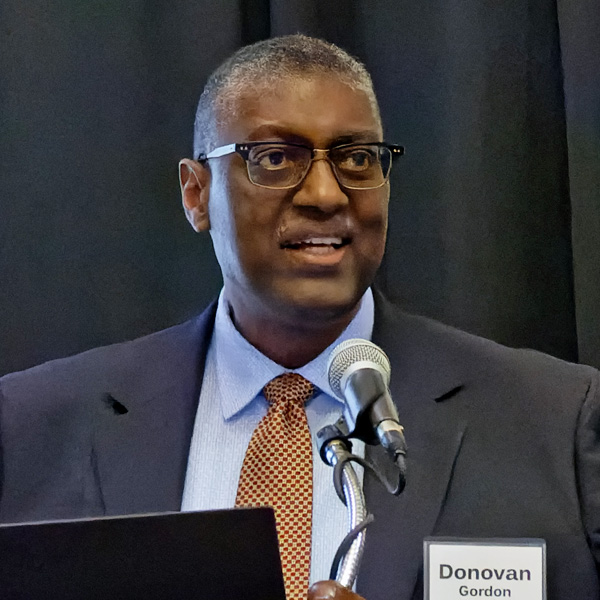 Donovan Gordon, NYSERDA | © RTO Insider LLC
Donovan Gordon, NYSERDA | © RTO Insider LLC
Donovan Gordon, NYSERDA’s director of clean heating and cooling, said the various pilot projects are a good mix of upstate and downstate, and are advancing through the review process. He urged NY-GEO to keep the momentum going by doing good work; people need to trust that ground-source heat pumps will deliver on their promise, he said.
“If we’re selling this product, let’s make sure that it’s reliable and they can count on it when they really need it,” Gordon said.
And then we need to let the world know it, he said.
“One thing I learned very early on is that in order for geothermal to succeed, we need a champion. So, we want to identify who the champions are — certainly at the municipal level; the developer level; the building owner level; wherever we can — and help them so they can really push the cause and get things done within their community.”
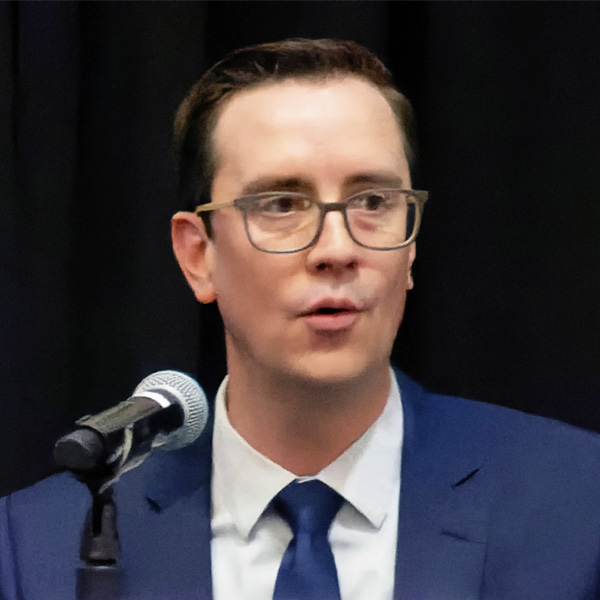 Daniel Ellis, Comfortworks | © RTO Insider LLC
Daniel Ellis, Comfortworks | © RTO Insider LLC
Daniel Ellis of Comfortworks said the shortage of drilling contractors notwithstanding, the ground-source heat pump industry is in an excellent position in 2023.
“It takes three things to make the market really fly,” he said. “You have to have high energy costs; you have to have some form of incentive; and you have to have an economy where things are being built and renovated. Right now, I think we’re at a pretty good situation. Anything could change in a heartbeat, economy-wise or whatever, but we have all the things lined up.”
Continual Effort
A plenary discussion was titled “Worst to First,” a reference to the economics of geothermal heat and government support for it as a means of decarbonizing buildings.
The discussion’s moderator said this was a bit of an exaggeration: Geothermal was never really worst, and there still are a few things to unpack in the IRA before it can be first.
But worst to first describes the ups and downs of an industry campaign that started in the Carter administration and has continued with dashed hopes, false starts and steady lobbying to gain recognition and subsidies for geothermal as a legitimate way to save money and the planet.
What could have been a seminal moment for the industry came and went 30 years ago, when the EPA report “Space Conditioning: The Next Frontier” declared electric ground-source heat pumps the cleanest, most efficient means of interior temperature control.
 Ryan Dougherty, Geothermal Exchange Organization | © RTO Insider LLC
Ryan Dougherty, Geothermal Exchange Organization | © RTO Insider LLC
Through politics, legislative horse trading and apparent clerical errors, geothermal became one of the “orphan technologies” excluded from subsidy programs, along with small wind, fuel cells and microturbines, Geothermal Exchange Organization President Ryan Dougherty said.
Things began to look up in 2018, when federal incentives were reinstated, but persistent lobbying — right up to and after passage of the IRA in 2022 — finally turned the page for geothermal, he said.
“But it’s not like flipping a light switch,” Dougherty said. “We’re still in many ways building back.”
A geothermal heat pump system is an expensive upfront investment that will yield immediate dividends for GHG reduction but take years or decades to provide return on investment for the building owner, depending on the cost of fossil fuels and electricity. It is also just one piece of a much larger bill spread over the next few decades. How much the energy transition will cost and how that cost will be allocated is still unknown.
And if the transition is to be anything close to complete or equitable, someone must pick up the tab for the Americans who cannot afford big increases in taxes or utility rates or housing costs.
One session of 2023 NY-GEO was titled “Who Will Pay for Building Electrification,” but it centered more on “Who Must NOT Pay”: the imperative that low- and middle-income residents not be stuck with the bill. It was suggested that all the money being spent to maintain and expand gas utility infrastructure be spent instead on electrifying housing, but no one noted that ratepayers presumably would bear the cost either way.
Then there is the housing itself: About 45% of New York state’s housing stock consists of rental units whose residents have limited ability to make upgrades and whose owners have little incentive to do the work, absent the carrot and stick of government regulation.
In New York City, 67% of the housing is rented and the poverty rate is significantly higher than the rest of the state and nation. An apartment on the Brooklyn waterfront can run $5,000/month. Market-rate units in Lendlease’s high-tech no-carbon complex at 1 Java will go for $7,000 to $10,000/month, CNBC reported last week.
“We have some big challenges because New York has some very old building stock,” said Jessica Azulay, executive director of the Alliance for a Green Economy. “A lot of these older houses are in dire need of repairs, upgrades, weatherization and electrical work before they can electrify.”
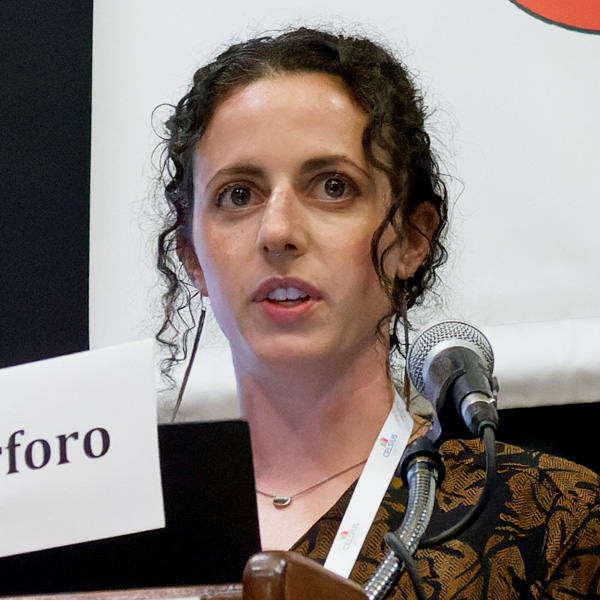 Annie Carforo, WE ACT for Environmental Justice | © RTO Insider LLC
Annie Carforo, WE ACT for Environmental Justice | © RTO Insider LLC
Annie Carforo of WE ACT for Environmental Justice related a pilot project that replaced gas stoves with electric induction ranges in 10 apartments in a housing authority building in New York’s poorest county. Everyone loved them, and nitrogen oxide levels dropped 35% in the air in those 10 apartments. But the project had to be fanned out horizontally across the building; the electrical circuitry could support only two induction ranges per vertical stack of apartments in the six-story structure.
Challenges like these are multiplied across the 177,000 units of the New York City Housing Authority, which reports it has a $40 billion backlog of deferred maintenance after decades of funding cuts.
“That is going to be a barrier to doing a lot of this electrification work,” Carforo said. Government funding streams for doing this work are siloed and inflexible, she added.
Drill, Baby, Drill
Outside the meeting rooms at 2023 NY-GEO, NetZero Insider spoke to exhibitors representing a sales company, an installation contractor, a utility, and an inventor and manufacturer. Each offered a distinct perspective, but all gave an upbeat appraisal of the prospects for geothermal heating and cooling.
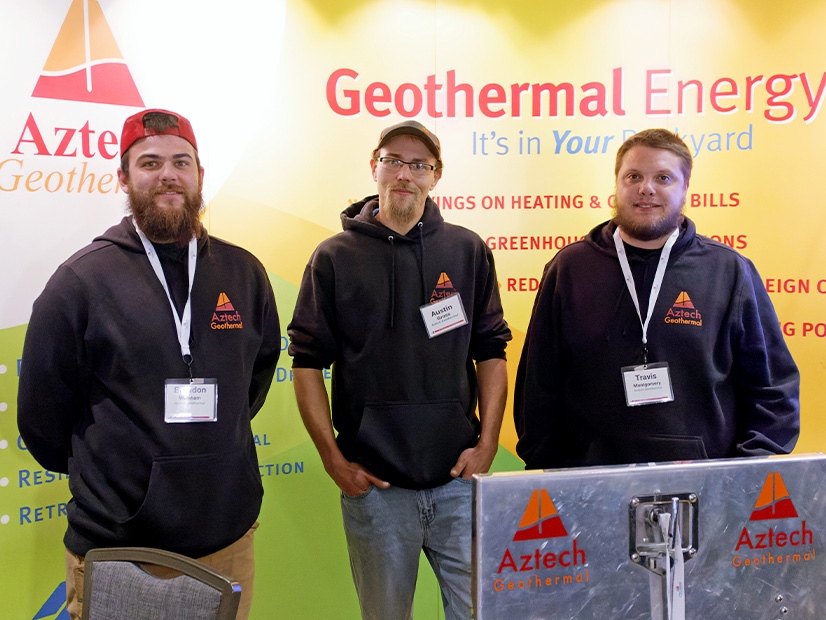 Jonathan Tham, PSEG Long Island | © RTO Insider LLC
Jonathan Tham, PSEG Long Island | © RTO Insider LLC
“I used to come to these events to find moral support!” said Jonathan Tham, administrator of PSEG Long Island’s Home Comfort Program. “There’s definitely a larger interest [now]. I’ve been in this field for more than 30 years. It used to be that I would have to go and sell green environmental technology; now they’re coming to us. But that’s been the case for the last five years; the awareness is there. …
“We’ve changed from thinking about energy efficiency in terms of dollars to carbon. We’re basically saying we don’t want any emissions.”
Tham promotes air-source and ground-source heat pumps with equal enthusiasm. The biggest obstacles to adoption, particularly for ground-source heat pumps, remain the high cost of installation and the limited availability of contractors to do the work, he said.
Aztech Geothermal Service Manager Austin Gross said government incentives are important to continued adoption of the technology. Their cancellation several years ago choked off consumer interest in his company, which is based near Albany and works almost entirely on residential projects.
Incentives were restored and later enhanced by the IRA.
 From left: Brandon Wickham, Austin Gross and Travis Montgomery of Aztech Geothermal are shown at the 2023 NY-GEO conference. | © RTO Insider LLC
From left: Brandon Wickham, Austin Gross and Travis Montgomery of Aztech Geothermal are shown at the 2023 NY-GEO conference. | © RTO Insider LLC
“It’s backed us out of the corner; it’s given us a lot more breathing room to at least be competitive with conventional systems,” Gross said.
Aztech contracts its bore drilling, and like many others during the conference, Gross flagged the shortage of drillers as a problem. Not only are there not enough to begin with, many shy away from drilling geothermal systems. They have enough business drilling water wells that they need not bother with what is a familiar process but an unfamiliar application.
“It’s an entirely new market for a lot of drillers to be able to step into,” he said.
Energy Catalyst Technologies grew out of a young engineer’s frustration at the lack of options to convert his home to geothermal heat. Like many houses in the Northeast, it is an older building with a hydronic heating system — hot water running through pipes — that would be expensive and disruptive to replace.
“A lot of times in a home with radiators — like our own — someone will come by and say, ‘Rip out all the radiators, and let’s put in some air ducts, mini splits or something like that,’” said Marketing Director Emily Desmarais.
So, founder Matthew Desmarais designed a double hybrid heat pump, warming hot water and circulating it through the radiators in winter. In the summer, it generates hot water for domestic use and can double as an air conditioning system for the first floor with a relatively small amount of ductwork, if the basement is unfinished.
Now four years old and out of the startup phase, Energy Catalyst is hoping to grow with the geothermal industry.
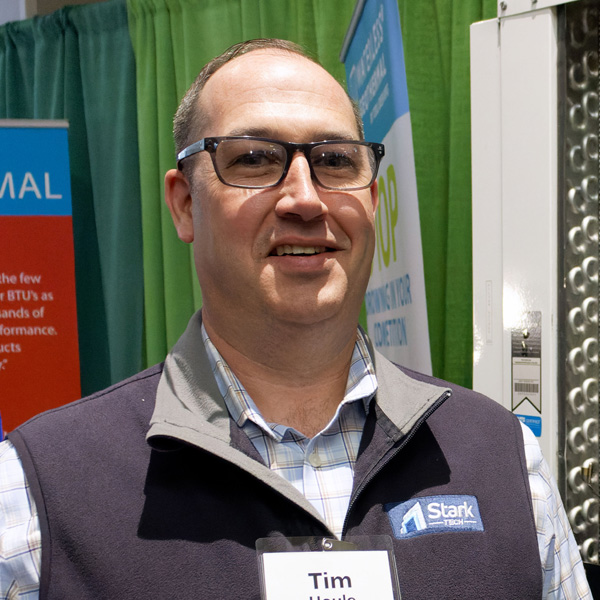 Tim Houle, Stark Tech | © RTO Insider LLC
Tim Houle, Stark Tech | © RTO Insider LLC
Tim Houle of Stark Tech was showing off a water furnace ground-source heat pump at the expo. He sees momentum in the industry, with ground-source heat pumps now getting consideration against their less expensive air-source counterparts or against fossil-fuel systems because of incentives to bring the cost down.
“We’ve been doing it forever; now it’s more of a desired technology,” he said.
Stark works on the commercial scale — schools, office buildings, industrial sites and really, really large houses. The motivation for such conversions ranges from a desire to go carbon-free, to a desire to publicly promote oneself as carbon-free, to simply getting away from expensive oil heat.
There is also a desire or need to get ahead of regulations, Houle said, as a growing number of jurisdictions are mandating that buildings go carbon-free.
New York is poised to be the latest.
As 2023 NY-GEO wound down Thursday, Gov. Kathy Hochul announced a conceptual agreement on the state’s long-overdue 2023-2024 budget. Among the welter of critical policy issues baked into the spending plan is a ban on fossil fuel systems in new construction. (See related story, NY to Begin Banning Gas in new Construction in 2026.)



